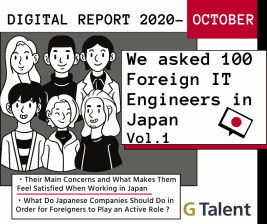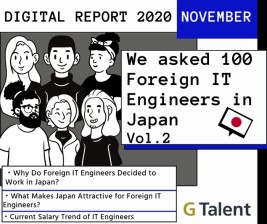Explanation of the qualifications and application procedures required to apply for employment as a foreign engineer
When foreign engineers apply for employment with Japanese companies, they need to have different qualifications and apply in a different way to when they are looking for work in their own country. In order to get hired smoothly, it is important for foreign engineers to know the qualifications and application methods they need to get hired in Japan.In this article, we will explain the types of residence status and application methods required for foreign engineers to be hired by Japanese companies, as well as the points to note and the types of foreign engineers who are hired by Japanese companies. For foreign engineers who want to be hired in Japan, your chances of being hired will increase if you make use of the job-placement agency “G Talent”, which specializes in foreign engineers.Residence status required for foreign engineers to be hired by Japanese companiesThe following four types of residence status are available to foreign engineers seeking employment at Japanese companies.Highly Skilled ProfessionalEngineer/Specialist in Humanities/International ServicesDesignated ActivitiesResidence Status Based on Status or Status of ResidenceHighly Skilled ProfessionalHighly-Skilled Professional is a residence status for hiring talented people from overseas. It is approved for a variety of occupations in Japan, and you can work as an engineer.The Highly-Skilled Professional visa application screening criteria has introduced a “Highly-Skilled Professional Points System”. Academic background, work experience, research achievements at universities, annual income, bonuses, etc. are used as screening criteria, and if you have more than 70 points, you can obtain a visa.If you meet conditions such as graduating from a famous university or graduate school, obtaining JLPT N1, or having an annual income of over 4 million yen, you have a high chance of being eligible for a Highly-Skilled Professional visa.Reference: 外国人エンジニアを採用するときに必要な在留資格の条件・申請方法/jopus bizEngineer/Specialist in Humanities/International ServicesIn the case of foreign engineers, if they meet the technical requirements, they can work as engineers under the Engineer, Specialist in Humanities/International Services status of residence. In order to obtain the Engineer status of residence, in addition to the conditions for foreign workers, there are also conditions for the company that will be accepting the foreign worker. We will explain each of these conditions in detail.Conditions for obtaining a “Engineer/Specialist in Humanities/International Services” visaIn order to meet the requirements for a “Engineer/Specialist in Humanities/International Services” visa, you must either have “at least 10 years of work experience” or “have majored in a subject related to the job you will be doing at university or a vocational school”.However, if you have passed an examination on information processing technology set by the Ministry of Justice, you may be exempted from the academic and work experience requirements. It is helpful to obtain an appropriate IT-related examination conducted in your home country to obtain a visa.You can check the items of the examination on information processing technology set by the Ministry of Justice on the Ministry of Justice website. For example, the following qualifications are recognized by the Ministry of Justice for Vietnamese engineers to obtain a “technology” visa status in order to be employed in Japan.The following examinations conducted by the High-Tech Incubation Training Center (HITC)(1) Fundamental Information Technology Engineer Examination(2) Applied Information Technology Engineer ExaminationExaminations conducted by the Vietnam Information Technology Examination and Training Support Center or the Vietnam Training and Examination Center, including the following(1) Fundamental Information Technology Engineer Examination(2) Software development engineer (software design and development engineer) test(3) Applied information technology engineer (applied information technology engineer) testIn addition, the company that employs the foreign engineer must meet three conditions: “specialization and relevance of job content”, “remuneration equivalent to or higher than that of Japanese employees”, and “business stability and continuity”. By fulfilling all of these conditions, it will be possible to accept foreign engineers.Reference: 入国管理及び難民認定法第七条第一項第二号の基準を定める省令の技術・人文知識・国際業務の在留資格に係る基準の特例を定める件/出入国在留管理庁Designated ActivitiesDesignated Activities is a work visa that can be obtained by foreigners who are engaged in specific activities that do not fall under any other status of residence. For example, this includes working holiday makers, students looking for work after graduating from school, students in Japan on internships, spouses of highly-skilled foreign professionals, and domestic helpers for diplomats.However, as the “special activities” visa is a short-stay visa for 6 months or 1 year, in order to work for a long period of time, it is necessary to switch to a status of residence such as “Engineer/Specialist in Humanities/International Services”.Reference: 在留資格「特定活動」/出入国在留管理庁Status of Residence Based on Status or StatusThere are four types of status of residence that have no restrictions on working: permanent resident, spouse or child of Japanese national, spouse or child of permanent resident, and long-term resident. As you can work in the same way as Japanese people, there is no need to apply for a status of residence.Reference: 「就労に制限のある在留資格」と「就労に制限のない在留資格」/行政書士・社会保険労務士永井弘行事務所How to apply for a residency status to apply for employment as a foreign engineerTo smoothly apply for a residency status to apply for employment as a foreign engineer, please familiarize yourself with the following procedures.Necessary documentsFlow of proceduresNecessary documentsIf you meet the requirements for obtaining a visa that allows you to work in Japan, you should prepare the documents you will submit to the Immigration Bureau. The foreign national themselves will need to prepare things like their graduation certificate, resume, and passport.As there are many documents that need to be prepared, it is important to do so with plenty of time to spare. If you have any worries or problems regarding work visas, you can consult with a government-certified lawyer, although there will be a fee.The company that will be accepting you will also need to prepare documents. The documents that companies prepare will differ depending on the size of the company, and the smaller the company, the more documents they will need to prepare.You can check the details of the necessary documents on the Ministry of Justice website. As the documents will differ depending on the visa you are applying for, you should check the documents required for the status of residence (such as Highly Skilled Professional, or Engineer/Specialist in Humanities/International Services) that is likely to be approved based on your career history.Reference: 【2021年版】 図で分かる就労ビザの必須書類一式/jopus bizFlow of proceduresObtaining a visa requires a period of 2 weeks to 1 month from the preparation of documents to the application. It takes about 1 to 2 months until the results of the screening are announced.If you need to apply for a change of status of residence or visa, you should allow for the time it takes to process your application, as well as the time it takes to join the company. From receiving an offer to joining the company, you should allow approximately 2 to 3 months.Reference: 外国人採用するなら知っておくべき就労ビザ取得期間 ビザ申請が間に合わないと国外退去になってしまうの?/Guidable JobsPoints to note when foreign engineers apply for a residence statusWhen foreign engineers apply for a residence status, there are three points to note.If the actual work content differs from the residence status, it will be considered illegal employmentThere may be cases where it takes time to be approvedThere are also ways to acquire information processing technology qualifications in place of academic background and work experienceIf the actual work content differs from the residence status, it will be considered illegal employmentEven if you are hired as an engineer, if the actual work you do is different to the content of your visa status, you will be considered to be working illegally. Before you are hired, be sure to check the details of the work you will be doing.For example, if you are hired as an engineer but the actual work you do is general office work, you will be working illegally.Reference: 外国人エンジニアに必要な在留資格や就労可能な職種の種類、注意点[グローバルエンジニア2]/FellowshipThere may be cases where it takes time to be approvedFrom the time you apply for a work visa until the screening process is complete, it may take some time. To ensure that your status of residence is in order by the time you start work as an engineer, you should allow yourself plenty of time.We recommend that you allow yourself around 2 to 3 months from the time you are confirmed as an employee to the time you start work.Reference: 就労ビザの審査期間はどのくらい?/外国人雇用&就労ビザ相談センターThere are also ways to acquire information processing technology qualifications in place of academic background and work experienceIn order to acquire a status of residence of “Engineer/Specialist in Humanities/International Services”, you must either have “at least 10 years of work experience” or “have majored in a subject related to the duties you will be engaged in at university or a vocational school”. However, even if you do not have work experience or a university major related to the job you want to do, you may be able to have the requirement waived by passing an information technology exam set by the Ministry of Justice.If you are a foreign engineer who wants to work in Japan as an engineer with no experience, you may be able to work in Japan by studying to pass a qualification exam.Reference: 技術ビザ - IT資格/TN行政書士事務所Types of jobs for foreign engineers who are hired by Japanese companiesThere are many different types of engineers. The following are some of the types of foreign engineers who have been employed by Japanese companies.ProgrammerSoftware engineerSystems engineerSecurity engineerIT consultantProject leaderProject managerProgrammerProgrammers are software and systems programmers who work based on the specifications created by engineers in upstream processes such as systems engineers, project managers and project leaders.They are required to have the ability to investigate and solve problems on their own, such as adjusting for program deficiencies and finding and fixing bugs.Reference: プログラマーとは?なり方や仕事内容、将来性を紹介/デジタルハリウッド大学Software EngineerSoftware engineers are in charge of developing a wide range of software, including PC and smartphone applications, and applications that control home appliances and public transportation. Their duties include development, design, software operation and maintenance, and testing.This is a job that requires knowledge and skills in development environments and programming, as well as communication skills with customers and team members.Reference: ソフトウェアエンジニアになるには?必要なスキルや年収を紹介/HiPro TechSystem EngineerA system engineer is a job that involves defining system development requirements, designing, testing, etc. In some cases, the system engineer only defines the requirements and creates specifications, leaving the actual programming to the programmers. This is a job that requires communication skills with the people involved.The way you work will differ depending on the company. You may work for a company that receives orders for system development, or you may work as an in-house SE, developing, designing, operating and maintaining the systems needed within the company.Reference: SE(システムエンジニア)とは?SEの仕事内容と年収/IT業界まるわかりガイドSecurity EngineerSecurity engineers are engineers who work on servers, infrastructure, and information security. They design and develop systems to protect them from cyber attacks.This is a job that requires a high level of information sensitivity, as you need to be quick to catch information about security and respond to evolving cyber attacks.IT ConsultantIT consultants are consultants who provide advice on all aspects of IT in client companies, propose system development and improvement, and provide support for implementation.They target clients who are having issues in the IT field, and propose solutions using IT technology. They are required to have the ability to think and make proposals, identifying the cause of the problem and proposing and developing appropriate solutions.Reference: 【需要増加】ITコンサルタントとは!?具体的な仕事内容や年収、有利な資格まで網羅的に解説!!/Executive LinkProject LeaderThe project leader is responsible for managing the progress of development, quality control and development team members as the leader of one section of the overall project under the management of the project manager. Working as a project leader opens the door to promotion to project manager.Reference: プロジェクトリーダーとは?仕事内容や必要なスキル、おすすめ資格を紹介/株式会社システムインテグレータProject ManagerAs the manager of the entire project, you will be responsible for a variety of tasks, including budget and schedule management, product quality control, and team member management. System engineers, programmers, and software engineers can advance to the position of project leader or project manager by gaining experience.Foreign engineers who want to work in Japan can get hired through “G Talent”In this article, we have explained the qualifications and application procedures required to apply for employment as a foreign engineer. The main types of residence status that allow you to work as an engineer in Japan are “Highly Skilled Professional” and “Engineer/Specialist in Humanities/International Services”.Check the necessary documents, the flow of procedures, and points to note, and make sure your application goes smoothly. There are various types of jobs available for foreign engineers in Japan. Get the necessary residence status and try your hand at building a career in Japan.Foreign engineers who want to get a job in Japan should use the job-placement agency “G Talent”, which specializes in foreign IT engineers. We provide strong support for foreign IT engineers who want to work in Japan, and you can also receive generous visa acquisition support.















